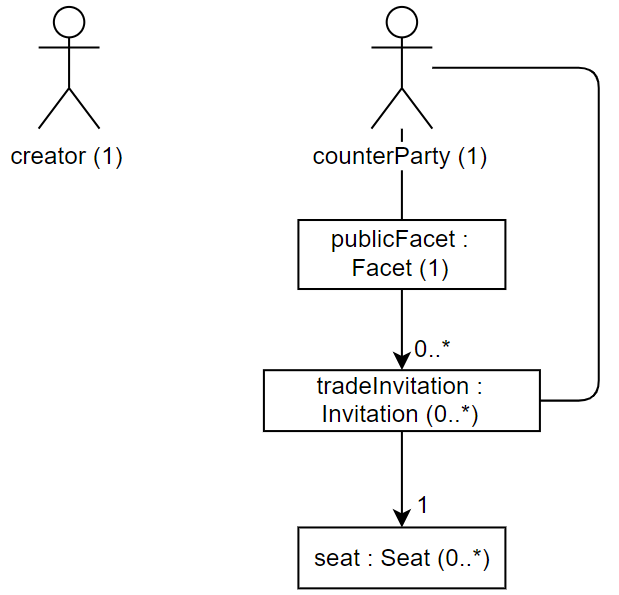The independent participation pattern
Intent
Giving the counterparty the right to create an arbitrary amount of invitations to participate in the smart contract.
Consequences
- Once the counterparty has the
publicFacet, the counterparty is no longer dependent on the creator. The counterparty is able to create its own invitations, and can thus participate in the smart contract whenever it pleases. - One instance of the smart contract guarantees an arbitrary amount of trades.
- The creator does not get to choose the counter parties that it will trade with.
Structure
Participants
- Creator: the entity that starts an instance of the smart contract.
- Counterparty: the entity that wants to trade with the creator.
Implementation
const start = zcf => {
const offerHandler = seat => {
//...
};
const publicFacet = Far('publicFacet', {
makeInvitation: () => zcf.makeInvitation(offerHandler, 'description');
});
return harden({ publicFacet });
};
harden(start);
export { start };
The smart contract returns a publicFacet which contains a
makeInvitation method to create invitations. This way, when the
creator shares the publicFacet with the counterparty, the counterparty
can create an arbitrary amount of invitations using the makeInvitation
method.
Known uses
- The automatic refund smart contract.
- The barter exchange smart contract.
- The mint and sell NFTs smart contract.
- The oracle smart contract.
- The sell items smart contract.
- The simple exchange smart contract.
- The use object smart contract.
Related patterns
- The dependent participation pattern: as explained in the dependent participation pattern, the independent participation pattern and the dependent participation pattern are almost identical. The difference is that in the independent participation pattern, the makeInvitation method is provided in the publicFacet and not the creatorFacet. This means that the counterparty does not depend on the creator to receive invitations.
- The bilateral trade pattern: these patterns relate since they both determine a way for a counterparty to receive invitations. The difference is that in the independent participation pattern, an arbitrary amount of invitations can be created for 1 instance of the smart contract, while in the bilateral trade agreement, only 1 invitation is created for 1 instance of the smart contract. Another difference is that in the independent participation pattern, the counterparty does not depend on the creator to receive an invitation.
